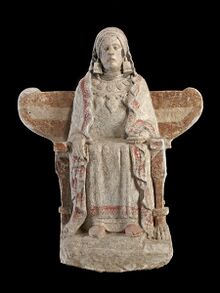سيدة بسطة
سيدة بسطة (إسپانية: la Dama de Baza ؛ إنگليزية: Lady of Baza) هي مثال شهير للنحت الأيبيري by the Bastetani. It is a limestone female figure with traces of painted detail in a stuccoed surface that was found on July 22, 1971, by Francisco José Presedo Velo, at Baza, in the Altiplano de Granada, the high tableland in the northeast of the province of Granada. The town of Baza was the site of the Ibero-Roman city of Basti and, in one of its two necropoleis, the Cerro del Santuario, the Lady of Baza was recovered. She is seated in an armchair, and an open space on the side is thought to have contained ashes from a cremation.[1]
The sculpture's name links it in the popular imagination to its more famous cousin, the Lady of Elche. After conservation, the sculpture, which dates to the fourth century BCE, joined the enigmatic Lady of Elche deposited in the National Archaeological Museum of Spain in Madrid. The chimera Bicha of Balazote and the standing Gran Dama Oferente, also called Dama del Cerro de los Santos, are exhibited in the same room of the museum.
. . . . . . . . . . . . . . . . . . . . . . . . . . . . . . . . . . . . . . . . . . . . . . . . . . . . . . . . . . . . . . . . . . . . . . . . . . . . . . . . . . . . . . . . . . . . . . . . . . . . . . . . . . . . . . . . . . . . . . . . . . . . . . . . . . . . . . . . . . . . . . . . . . . . . . . . . . . . . . . . . . . . . . . .
المراجع
- ^ Analyses of the sculpture were published by F. Presedo in "La necrópolis de Baza" (Madrid) 1982 pp 317-19 and plate, and by A. García y Bellido, Arte Ibérico en España (Madrid 1980) pp 52-56.
وصلات خارجية
| Dama de Baza
]].
